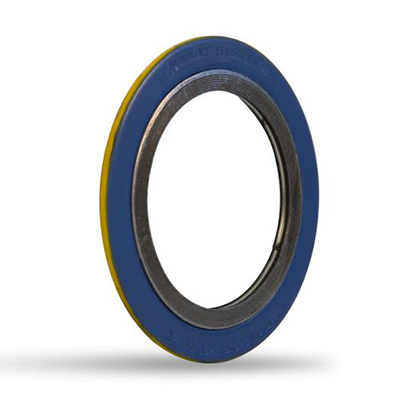Gallagher Fluid Seals partners with the world's top gasket suppliers. Our strong partnerships allow us to provide you with the best gasketing options, from PTFE, Metallic, and Compressed Non-Asbestos
Choosing the Correct Semi-Metallic Gasket
There are many variations of semi-metallic gasket available in today's market. The combination of metal and a soft gasket material merges the sealing ability of the soft material with the structural integrity of the metal.
The most common styles of semi-metallic gasket include spiral wound gaskets, corrugated, jacketed, and kammprofile gaskets.
Pumps & Systems magazine outlined the proper way to select a semi-metallic gasket.
Gasket selection suggestions
Choosing a gasket depends on a few different factors: operating conditions, fluid compatibility, mechanical features of the joint and the characteristics of the gasket.
To figure out which gasket to select, multiply the operating pressure in pounds per square inch by the operating temperature in Fahrenheit. If the result is greater than 250,000, you should use a semi-metallic gasket.
Spiral Wound Gaskets
These gaskets offer the best performance when compressed to a specific, predetermined thickness.
Control compressibility for a specific bolt loading by varying the density. Filler thickness may be anywhere from 0.015 inches to 0.031 inches.
Most applications will use two standard gasket thicknesses: 1/8 inch and 3/16 inch. With 1/8 inch thick gaskets, compression to a 0.100 inch thickness is recommended. For 3/16 inches, compress to a 0.13 inch thickness.
Spiral-wound gaskets can be used for general service with almost any commercially-made flange surface finish, although a 125-200 mean square finish is optimal.

Other semi-metallic gasket types include:
- Corrugated gaskets -- These gaskets are made of a thin metal, corrugated or embossed with concentric rings and faced with a softer material such as flexible graphite. As Pumps & Systems puts it: "Corrugated gaskets use the substrate’s geometry to achieve conformability to flange irregularities and promote recovery over the life of the seal; they are essentially a line contact seal."
- Jacketed gaskets -- These consist of a soft, compressible filler, partially or completely encased in a metal jacket. The main seal against leakage is the inner metal overlap, where the gasket's density is greatest when compressed.
- Kammprofile gaskets -- Also known as "camprofile," these gaskets are made from grooved metal with covering layers. They consist of a solid metal ring with grooved faces and soft facing material to improve sealability. Facing materials are typically graphite, phyllosilicates or PTFE.
Installing Spiral-Wound Gaskets
Spiral-wound gaskets are dimensioned so that their cross sections are smaller than the flange faces," Pumps & Systems writes. "When one of these gaskets is installed, the sealing surface is positioned so that it does not protrude past the inside diameter (ID) or the outside diameter (OD) of the flange faces."
You should always check the dimensions of the gaskets being used between a pipe and pressure vessel flange by:
- Measuring the ID of the flange contact face
- Measuring the gasket ID.
If the gasket ID isn't at least 1/8 inch larger than the flange ID, do not use it unless it can be installed perfectly centered.
"In no instance should the gasket ID be less than 1/8 inch larger than the flange contact face ID when used between pipe or pressure vessel flanges," Pumps & Systems says.
Bolting Up
Spiral-wound gaskets do not have the same feel as other gaskets during bolt up. It behaves more like a thick rubber gasket, "giving" as each bolt is tightened.
This is why it is important to tighten the bolts in small increments, and in the correct sequence. Do not tighten them all the way on the first attempt. This can tilt the flanges out of parallel. If you're using a torque wrench, set the tool to about one third of the final torque on your first attempt.
Pay close attention to hard-to-reach bolts, and repeat the procedure with the wrench at two-thirds of the final torque.
If your initial bolting attempts are done properly and in the right sequence, the final attempt doesn't need to follow a specific pattern. However, it's important that this final attempt be uniform, which each bolt evenly loaded.
This will achieve a trouble-free joint and prevent leaking.
Gallagher stocks many of these styles of gaskets at our fabrication and sales facility in East Longmeadow, MA.
Contact us today to learn more about your gasketing options.
